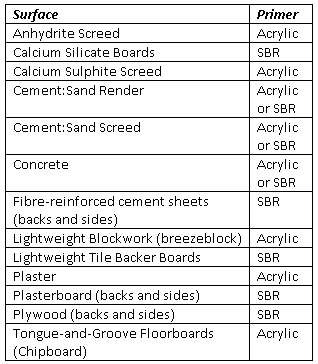Question: Can I Use PVA to Prime A Surface Before Tiling?
Short answer
No, never use PVA to prime a surface before applying tiles. The acetic acid produced when cement and PVA come into contact would render the adhesive and grout useless. Scroll down for a longer answer!
Long answer to ‘Can I Use PVA to Prime A Surface Before Tiling?’
Never use PVA in any tiling project under any circumstances. Here’s why:
PVA (Polyvinyl Acetate) is a rubbery synthetic polymer, commonly emulsified in water and used as glue. Many know it simply as “wood glue”, or “carpenter’s glue”.
Cementitious materials, such as many tile adhesives and grouts, or other materials which contain cement, such as concrete, are alkaline. Simplified, that means they have a high pH. Alkali slowly attacks polyvinyl acetate, forming acetic acid, which has a low pH. Cement adhesives don’t dry as such, they cure through hydration, which means they bind the water you mix them with chemically. This causes the pH of the substance to rise dramatically. Introducing an acid negates that process to some extent, preventing the cement from binding all the water it needs to harden properly.
It is hydration that gives cement adhesives strength and holds them together. Without this process, it would merely be the powder you started with which of course, is not sufficient for fixing tiles.
The acetic acid which is formed when cement and PVA comes into contact, either through mixing them, or “priming” with PVA, will continually free the water bound in the cement, which will weaken the bond and integrity of the material. The effect is accelerated if the material is subjected to moisture, which is more or less always the case.
PVA isn’t water resistant. It becomes slightly live when exposed to moisture, and this in combination with the exposure to alkali, accelerates the forming of acetic acid. PVA which is marketed as “water resistant” or “exterior grade”, has additives which makes them water resistant, but they’re not alkali-resistant.
Instead, you could use Acrylic or SBR (Styrene Butadine Rubber) type primers, depending on the substrate. These remain unaffected by contact with moisture and cement once dry, and can in some cases, drastically enhance the bond between the adhesive and substrate. They can also be used as a bonded protection barrier, where two substances may normally have adverse affects when in contact with each other (such as gypsum and cement).
This is a very basic guide to the various surfaces and correct priming methods. A few examples of both primer types are:
Acrylic – BAL APD, Ardex P51
SBR – BAL Bond SBR, Palace Tilers Primer, Norcros Prime Bond

Hopefully that answers the question ‘Can I Use PVA to Prime A Surface Before Tiling?’




